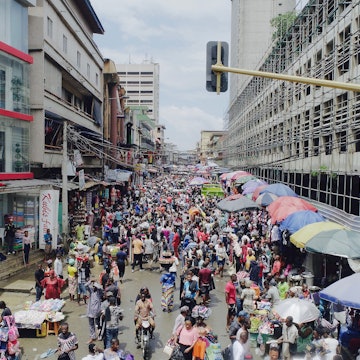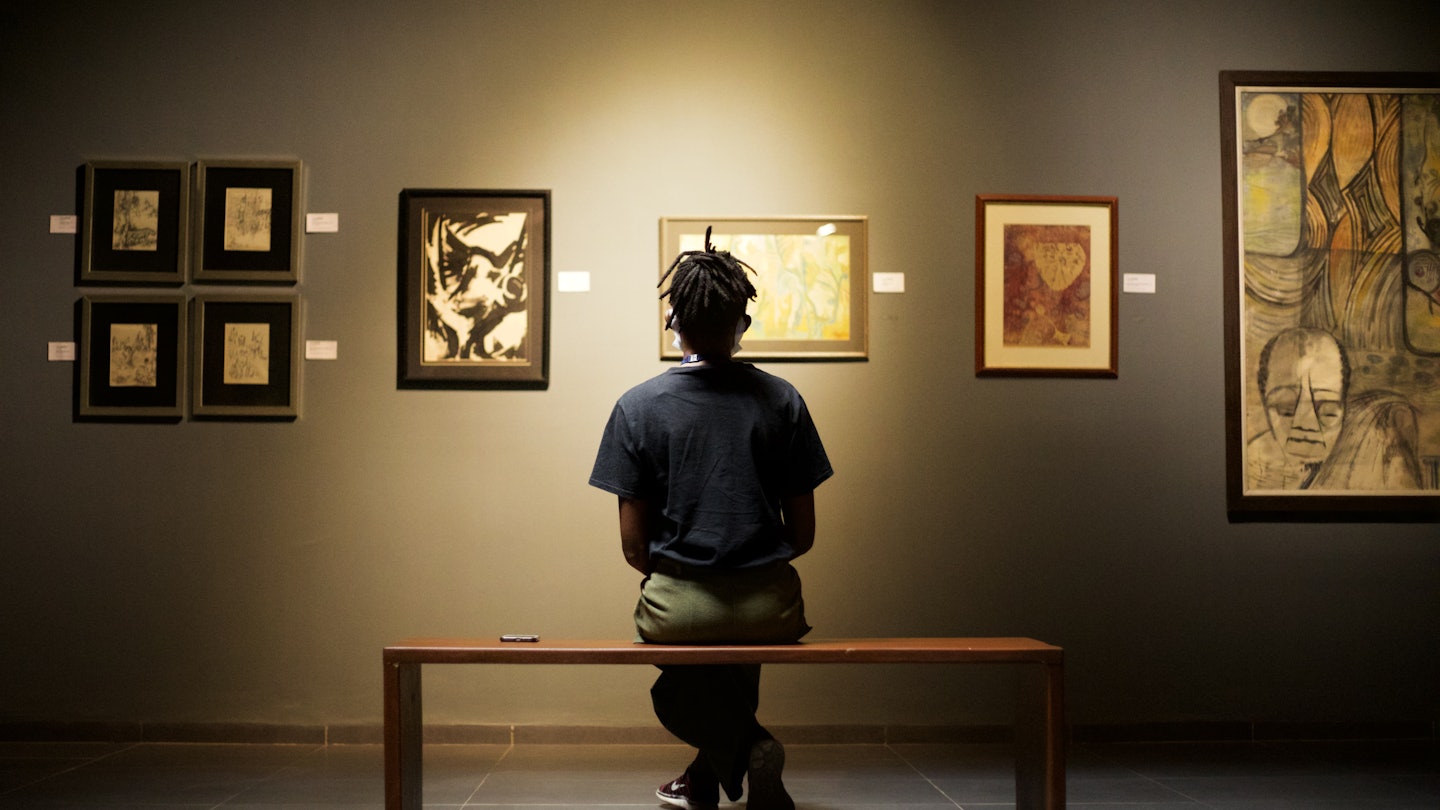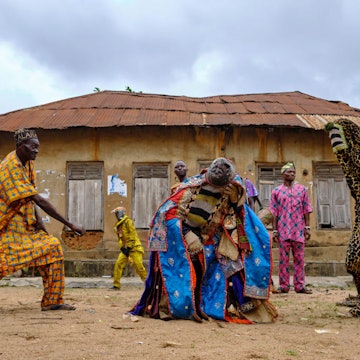

Find out how architecture meets contemporary art at Lagos' Yemisi Shyllon Museum © Yemisi Shyllon Museum of Art
Lagos packs a punch when it comes to culture, thanks to Nollywood, a vibrant music and fashion scene – and a lineup of museums that range from staid to exciting.
In this city of roughly 20 million, museumgoers can visit colonial-era institutions now managed by the government to contemporary art galleries funded by private individuals.
Many are easy to reach, while some will bring you to remote corners of the state. And perhaps the most exciting museum in Lagos yet – the John Randle Centre for Yoruba Culture and History – will open in the near future.
In the meantime, among those already welcoming visitors, here are the best museums in Lagos.
Consider Nigeria’s extraordinary culture at the National Museum
The National Museum was established in 1957 to house objects collected from archaeological digs carried out across the regions that now make up Nigeria. As visitors stroll through the museum’s breezy courtyard, they’ll take in rare carved stone objects and monoliths, part of Nigeria’s rich ancient rock-art heritage.
Such treasures as Ife and Nok terracottas and Benin Bronzes showcase the country’s stunning indigenous craftsmanship as far back as 900 BCE. Rotating exhibitions – such as Unfading Assets of Our Cultural Patrimony – also highlight objects from the permanent collection. The curators here are always newly contextualizing such works traditional stools and staffs, fly whisks, drums and an assortment of various royal ensembles as they celebrate Nigeria’s diverse cultural heritage.
Superb architecture meets contemporary art at the Yemisi Shyllon Museum

The Yemisi Shyllon Museum of Art is one of the most exquisite works of architecture in Lagos. Situated on the quiet campus of Pan-Atlantic University and opened to the public in 2020, this museum centers around a donation of some 1000 artworks by one of Nigeria’s foremost art collectors.
You can count on seeing an array of work by some of Nigeria’s most celebrated modern artists, including Aina Onabolu, Bruce Onabrakpeya, Ben Enwonwu, Yusuf Grillo, Ladi Kwali and Erhabor Emokpae. The displays are rounded out with vivid works by contemporary talents, as well as ancient archaeological objects and intricately carved, traditional wooden pieces. When you’re done in the galleries inside, linger a while in the equally soothing sculpture park.
Contemplate the legacy of slavery at Badagry Heritage Museum
Visitors to Badagry look forward to stopping in at its Heritage Museum, the centerpiece of a network of institutions and sites memorializing the transatlantic slave trade. Housed in a prefabricated one-story colonial-era building put up in 1863 as a District Officer’s station, this spacious compound includes a crafts shop, restaurant and a 30-foot monument.
Combining images, maps, illustrations and actual relics, the museum details the evolution of slavery, from gut-wrenching capture, resistance and punishment to its long-awaited abolition. Standing on the lagoon-facing balcony at the back of the building, visitors can see the port (dating as far back as 1510) in the distance and fringes of Gberefu Island, from which millions of enslaved people were marched to – then shipped out from – the point of no return.
It’s always “Highlife Time” at the Kalakuta Republic Museum
The Kalakuta Republic Museum is the go-to pilgrimage spot for fans of Fela Anikulapo-Kuti and the Afrobeat style of music he pioneered. At this three-story home-turned-homage to the master, the entire first floor is devoted to telling the Fela story, starting with his living quarters – left unchanged since when he died in August 1997 at age 58.
Marvel at his colorful, embroidered shirts, saxophone, award plaques, king-size mattress and waist-high fridge. Next door, you’ll see at least 30 pairs of his made-to-order shoes, while another room presents his short-lived foray into politics, complete with photocopied pages of press coverage of his bitter, and occasionally bloody, battles with the military junta of the 1970s and ’80s. Other rooms are plastered with photographs of some of his international performance tours. True devotees can finish their visit by paying their respects at Fela’s marble tomb, located on the ground floor.
Celebrate progress at Freedom Park Museum
This museum is part of the larger Freedom Park facility on Broad Street, which has its roots in the state’s colonial past. Founded as a prison in 1872, the compound was closed then demolished after Nigeria’s independence in 1960.
Occupying the upper section of what used to be the prison’s registry, the museum preserves the memory of the former jail. Visitors can see a replica of a typical cell (with bedding, a pail and Bible), carceral objects (including shackles and window bars) dug up during the foundation-laying stage, a reconstruction of the gallows, and a wall plastered with a long list of the everyday people and political activists who served time at the prison. A collection of photographs shows the prison’s original buildings and several stages of the redevelopment work carried out in the late 2000s.
Enjoy juxtapositions of Black art and objects from around the world at CBAAC Museum
Between January and February 1977, Lagos hosted the second World Black and African Festival of Arts and Culture (FESTAC), drawing hundreds of thousands of participants from at least 60 countries. The spectacle included regatta displays, concerts, colloquiums and an exhibition of objects from the participating countries.
The objects from that exhibition make up the collection of the Center for Black African Arts and Civilisation (CBAAC) on Broad Street. This cross-cultural displays Australian Aboriginal art, a soapstone from Zimbabwe, twin figurines from Cuba, fertility dolls from Ghana, ancestral objects from Ivory Coast and ornamental utensils, among many other pieces.
Since it’s run by a government agency, it’s only open on weekdays, and visitors are required to request tours by email (cbaac77@yahoo.com) in advance.
Everyday objects tell the story at the CRIMMD museum
Where in Lagos would you find a Nigerian coin that was minted in 1910, an 1884 stamp and a 1922 gramophone? The museum of the Center for Research, Information Management and Media Development (CRIMMD) has preserved all these and more, including a gun used during the 1897 British military assault on the kingdom of Benin.
Over the past two decades, the museum has preoccupied itself with collecting and preserving various aspects of Nigeria’s material culture. These objects in turn help visitors see and feel (sometimes literally) how the country has evolved from a colony into an independent nation. Also in its collection are such everyday objects as turntables, LPs, wick lanterns, royal staffs and various household utensils. In excess of 20,000 images, its photographic hoard is equally impressive.
Step back into a groovier time at Vintage Africana

Imagine the living room of a middle-class Nigerian family in 1970s and ’80, decorated with a black-and-white double-door television, table-top dial phone, grandfather clock, short-wave radio and cassette player, vinyl turntable, VHS player and floral wallpaper, among other furnishings.
Vintage Africana offers a veritable trip back in time. A Lagosian couple opened this intriguing space recently in the Oko-Oba–Agege area, motivated, they say, to preserve familiar objects from their own childhood so that kids growing up now can learn that there haven’t always been smartphones, cable television and digital cameras.
A vintage Volkswagen and Mercedes Benz 190 – the trendiest vehicles of their day – are both parked in the compound, a short distance from a telephone booth. A contemporary message sneaks into the first interior space visitors walk through: the “green room,” a silent campaign for recycling and upcycling. An adjoining restaurant serves Nigerian soul food: while waiting to be served, you can play card games, and flip through an old book of Yoruba proverbs or a selection of Shakespeare’s dramas.
Trash gets transformed into treasure at the Junkyard Museum of Awkward Things
What society throws away, the Junkman of Africa (also known as Dilomprizulike) takes up. He cut his teeth interning in the 1970s with world-famous artist El Anatsui, and has worked with found objects ever since in a career that’s spanned five decades.
Over the years, he has amassed a vast collection of beautiful detritus, exhibited at home and abroad – and now at his museum, nestled in a leafy corner of Lekki, one of Lagos’ loveliest neighborhoods. Still very much a work in progress, the museum is being prepared as a creative space for artists worldwide, at which Junkman plans to run workshops while also hosting international exchange programs and community-centered projects for young and aspiring artists.














